The changing face of Hastings Seafront
This article contains affiliate links. We may earn a small commission on items purchased through this article, but that does not affect our editorial judgement.
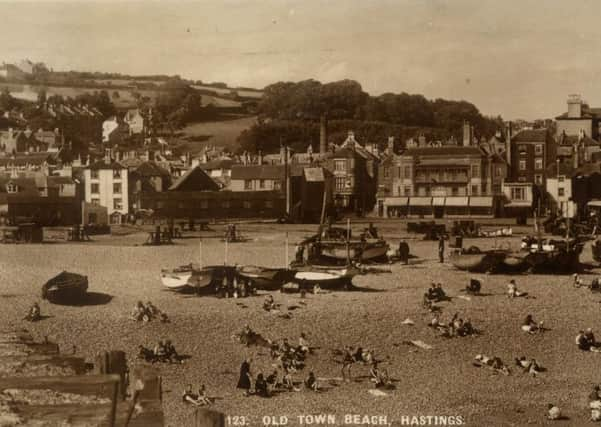

He writes: Townscapes change gradually over time as part of the evolutionary process over time but Hastings had an additional couple of factors; Sidney Little’s 1930’s town centre by-pass that provided an alternative route along the seafront, avoiding ‘The Memorial’ from the western end of Robertson Street to the Eastern end of Castle Street and the demolition of Beach Terrace in front of Pelham Crescent and shingle building up against the unfinished 1896 harbour arm caused this new road to find itself further and further from the sea and fresh enterprises then colonised the new found real estate.
The second world war, of course, contributed to the alteration of the townscape by destroying many fine buildings (and many not so fine) and subjecting many those that remained to six years of neglect as their owners either left the coast for somewhere safer or simply couldn’t obtain the resources to properly maintain their properties.
Advertisement
Hide AdAdvertisement
Hide AdAll illustrations throughout this series are from Ion Castro’s own collection and he can make available copies of many of the historic images used in this series. There’s more local history on Ion’s website, www.historichastings.co.uk
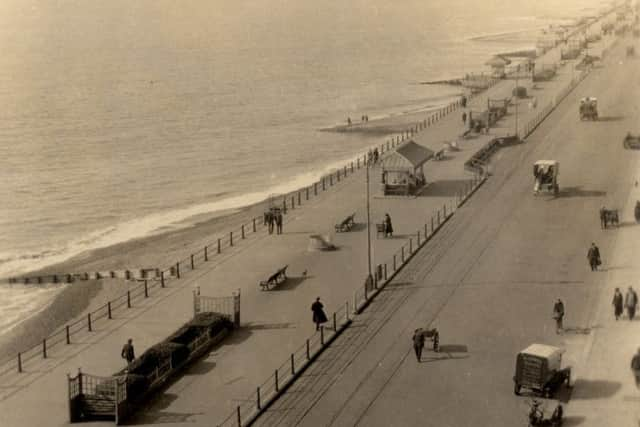

6069 Hastings, Beach & Palace Hotel.
This is an unusually sized postcard, (9¾inches x 3¾ inches or 245mm x 100mm) a ‘Panoramic Card’ from the Photochrom Company Ltd. of London and was published around 1908.It was designed to be sent, according to the instructions ornamenting the back ‘Halfpenny Packet Post’ and ‘No writing other than address and signature to be on this card’ The area in the foreground is now occupied by Sidney Little’s new (in the 1930’s) promenade and underground parking station. Hastings pier is still uncluttered up to the Pavilion on the end
95592 Parade and Pier, Looking West, Hastings.
Printed by well-known firm ‘Valentines’ but also labelled ‘Palace Stationery Depot, 27 WhiteRock’. This postcard shows how much space Sidney Little’s promenade was to occupy. Buildings are starting to encroach on the deck of Hastings Pier and St.Leonards Pier can e seen in the background. Today the roadway in the centre of the picture has been excavated to form the access to the underground parking
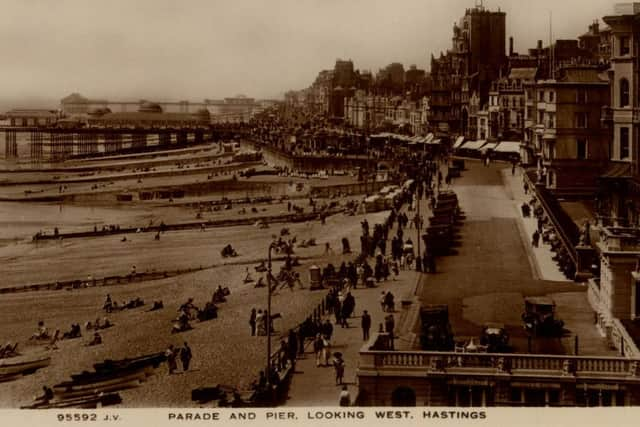

28 Hastings, - Carlisle Parade – LL.
This distinctive style of card, posted in 1912 was produced by the French firm of LL, not, as we now know, Louis Levy but Léon & Lévy, a French printing founded in 1864 and located in Paris. The image shows some of the beach lost to Sidney Little’s Promenade and underground car park. Notice the bathing machines, strictly segregated the gentlemen’s would be some distance away and notice too the rowing boats drawn up on the beach
123 Old Town Beach, Hastings.
Advertisement
Hide AdAdvertisement
Hide AdIn this image from the early 1930’s the inner end of the harbour arm can be seen and the current lifeboat house now occupies the area to the left of the picture. At the bottom of All Saints Street can be seen the building on the left that was replaced in the early 1950’s with the medieval-looking ‘Pulpitt Gate’, to the left of it is the chimney of Breeds’ Brewery. ‘The Bourne’ that was to smash its way through the Old Town was being planned but it would be another 30 years before it was built.
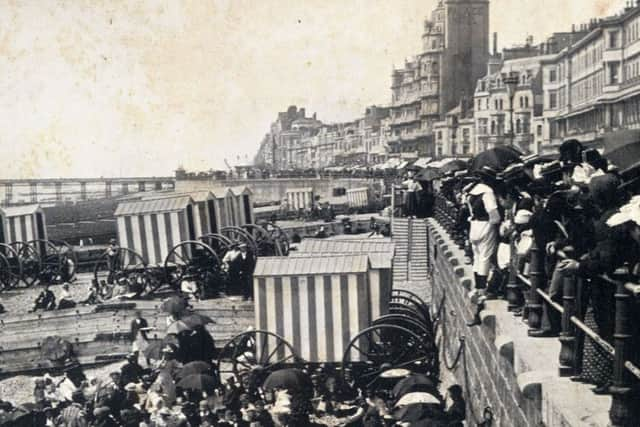

6 Hastings, - The Beach, - LL.
Another distinctive ‘LL’ postcard showing the beach at Harold Place around 1910, the area is now part of the seafront road and many of the houses dominating the shoreline were lost to enemy action in the last war. Drawn up on the beach is one of the large pleasure yachts that were so popular with the public, it is ready to receive passengers and has already been turned round in preparation for launching; notice as well the small rowing boats drawn up to high water mark, these too could be hired, with or without a boatman..
Promenade Looking West.
Captured by an unknown photographer during the first decade of the 20th century, probably from a vantage point in the Grand Hotel opposite Hastings Pier, we can see what the seafront looked like between Hastings Pier and Warrior Square with St.Leonards Pier in the distance before Bottle Alley with its raised promenade on top was built some 20+ years later.
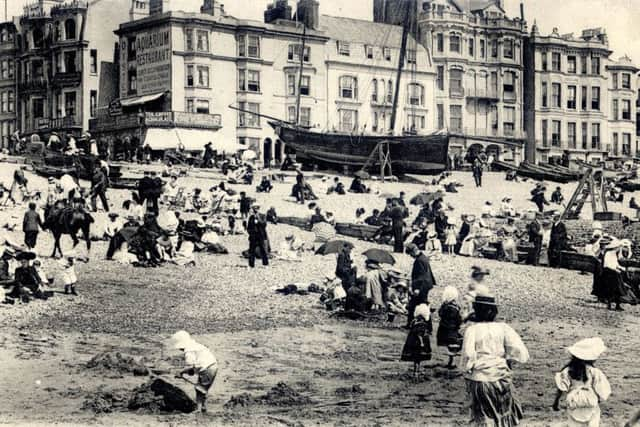

The seafront was one of the few places that Hastings Tramways had double-tracked, most tram routes in the borough managed on single track with passing loops.
Advertisement
Hide AdAdvertisement
Hide AdWhen trams started running along the seafront in 1907 electricity to run the trams was supplied by the Dolter Stud system where current at 500volts DC was drawn from studs in the road contacting a skid mounted under the tram and energised by the passing of the tram, this avoided using overhead wiring which was perceived as unsightly.
Clearly the engineers overlooked the fact that water, especially salt water usually found on a seafront and electricity don’t get on well together and there were problems which, in 1914, were circumvented by having petrol generators mounted under the stairs ensuring that passengers got a good dose of petrol fumes to enjoy.
Finally, in 1921 the corporation relented and overhead wiring was installed until the trams were replaced with trolleybuses in 1928, they too needed electricity drawn from the overhead but were not restricted by having to run on rails.
Having both tracks on one side of the road didn’t initially cause problems until motorcar ownership and usage increased and the ancient British custom of driving on the left was enforced. Magnifications reveals that the man in the foreground with the sandwich boards is advertising luncheons for 1/6 (7½p) at the ‘Black Cat’ and, in the centre of the picture the motor van is delivering for ‘Plummer Roddis’ – now Debenhams.
Advertisement
Hide AdAdvertisement
Hide AdDon’t miss out on all the latest breaking news where you live.
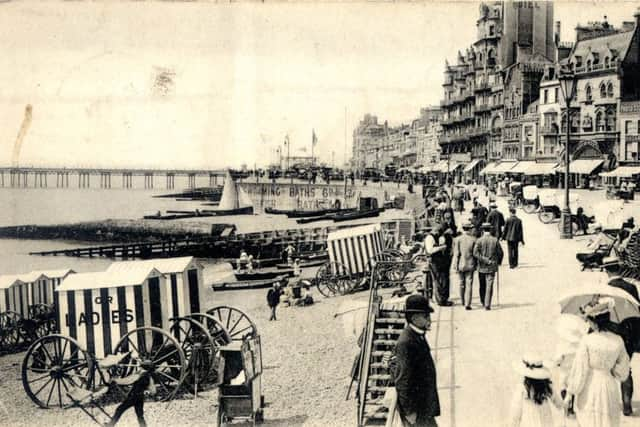

Here are four ways you can be sure you’ll be amongst the first to know what’s going on.
1 Make our website your homepage at www.hastingsobserver.co.uk
2 Like our Facebook page at www.facebook.com/hastingsobserver
3 Follow us on Twitter @HastingsObs
Advertisement
Hide AdAdvertisement
Hide Ad4 Register with us by clicking on ‘sign in’ (top right corner). You can then receive our daily newsletter AND add your point of view to stories that you read here.
And do share with your family and friends - so they don’t miss out!
The Hastings Observer - always the first with your local news.
Be part of it.